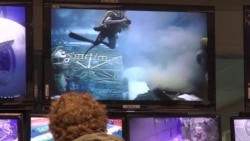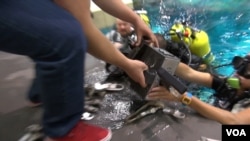Scuba divers worked a crank on a metal box that soon sent up a cloud of dust from the pallet of gravel where the device was anchored. Watching them closely on control room monitors, Matthew Morrow, an engineering student from West Virginia University, provided instructions.
“The only reference is the driver’s non-dominant hand should be grasping the handle on the side of the case,” he said.
Morrow was the project manager for a team of West Virginia University students who designed and built the device that was tested in the world’s largest swimming pool (22.7 million-liter, 12-meter-deep), the Neutral Buoyancy Laboratory, at NASA’s Johnson Space Center in Houston, which is used for training astronauts in an approximation of microgravity.
The U.S. space agency invited college students from around the country to design, build and test devices and tools that could be useful on future missions. NASA selected 25 teams and invited them to Houston to test their creations.
Asteroid material sampling
The main mission for which these tools would be needed is NASA’s Asteroid Redirect Mission, said NASA’s Microgravity Next Program Manager Trinesha Dixon.
“The Asteroid Redirect Mission is looking for solutions as to how the crew members might collect samples on an asteroid,” she said.
NASA plans to send an unmanned spacecraft to an asteroid in September to extract small samples for analysis. A mission with astronauts on board is planned for sometime after 2020, utilizing the Orion spacecraft, a model of which is in the Johnson Space Center training facility.
Dixon said part of the difficulty in designing tools for such a mission is that no one knows what kind of material will be found on an asteroid, how hard it will be to penetrate, and what kind of effect might be produced by drilling or chopping into it.
After divers returned their device at pool’s edge, the West Virginia University students took it back to the large hall where each team had a separate table. There, they took it apart and carefully cleaned all the parts, including the two augurs that would be utilized to drill into the surface of an asteroid and extract material. Coming from a state known for mining, the team initially modeled its device on mechanisms used in mines that clamp to a surface and hold the drill steady.
Mathew Morrow explained, “When astronauts visit an asteroid, they need a tool out on the asteroid that can anchor, to hook their tools to, so we chose that design challenge.”
NASA supplied criteria for five separate types of tools or devices and let the students use their creativity and knowledge of engineering to come up with designs. Once the designs were accepted, they then had to build a prototype for testing.
“This is all student driven,” said West Virginia University College of Engineering and Mineral Resources professor Thomas Evans, who accompanied the three-student team to Houston. “I was just the faculty adviser and mentored them and drove them to deliver a product on time so they could be down here.”
Their device worked even better than expected, according to Evans.
“It was exceptional! I think this team did a fantastic job,” he said.
Evans said the West Virginia University team benefited from frequent visits to NASA’s Goddard Space Flight Center in the neighboring state of Maryland, where Mathew Morrow had an internship.
Ideas NASA can use for space tool development
The experience was exciting for the students involved, but they may also one day see some of the elements in their designs used in devices that astronauts employ in space.
NASA’s Dixon said, “We can take components from different tools, concepts that the student teams might come up with, and put them together in our conceptualization of that tool.”
In addition to that, she said, having such a program encourages students interested in space flight to continue their studies and possibly become part of NASA’s future work force.
Mathew Morrow is one who has such hopes.
“I am really hoping that there might be an opportunity there (NASA) or somewhere else in the space industry, whether it be in a private company or with the government.”
Opportunities in the private sector for space engineers have diversified from being mainly contractors building rockets and other equipment for NASA to service companies with their own spacecraft that can ferry supplies to the International Space Station, and may one day take passengers into space and become involved in efforts to extract minerals and other resources from the moon, asteroids or other planets.











